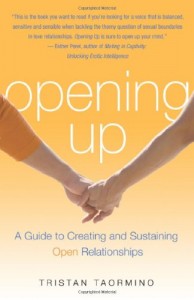This is part of a shared reading of Opening Up. Visit the series introduction to catch up on past installments. Comments are always welcome, whether you’re reading along with us or not.
In this installment, we discuss Chapter 2, “Myths About Nonmonogamy”
There are lots of misconceptions about human relationships. In a way, books like this one exist to bust the largest myth, which is that strict monogamy (or in actual practice, serial monogamy) is the only way to build relationships. From birth, our culture presents us with a script for how our lives are to go — largely, a monogamous, heterosexual script based on an outdated concept, the “nuclear family,” which ignores the many shapes families and relationships actually take.

This chapter addresses a few specific myths. Let’s go through them one by one, and then address a few of our own.
Human beings were meant to be monogamous; like other animals, it’s how we bond and mate.
Tristan Taormino mentions the excellent book The Myth of Monogamy, which addresses this myth in a very general sense. Very few animals are truly monogamous — that is, they not only mate for life but only have sex with that mate for the entirety of their lifetimes. Even many animals trumpeted as paragons of monogamy in Disneyfied nature documentaries will rarely pass up the opportunity for a little “taste of strange” on the side. Since the publication of Opening Up another book came out which I often reference on this blog: Sex at Dawn. It takes a more specific look at human sexuality and all the evidence which points to humanity’s non-monogamous origins.
Open relationships are unnatural, abnormal, and immoral.
If non-monogamy is actually our natural state, then it quickly becomes clear to me that all relationship styles are just different attempts to put structure around our natural urges and desires. Whether one chooses strict monogamy, total non-monogamy or something in between, every choice should be seen as an attempt to honestly balance the desires of the people involved with the need for safety, a sense of security, and so on. Whether it leaves people satisfied and happy is the barometer here, not whether it is what other people do.
Polyamory is what Mormons practice.
Obviously, most people reading this blog entry already know this is untrue. It’s undeniable that this myth affects those who practice non-monogamy, however. Laws targeting religious polygamy also affect the non-monogamous, regardless of belief. For one example, Canadian activists are struggling against their nation’s polygamy law and its implications for their relationships.
People in open relationships have psychological problems.
Our culture teaches us that if people are different from cultural norms, then there is a reason — more specifically, even otherwise supportive acting outsiders may want to point to something that “went wrong.” This idea shows up in many places, not just for those in open relationships, but for those who are kinky, or queer. True acceptance is not looking at gay people as “broken” straight people, assuming all kinky behavior stems from childhood abuse; it’s just as wrong to assume the same of the nonmonogamous.
People in open relationships have intimacy issues and trouble with commitment.
Tristan Taormino writes: “People in nonmonogamous relationships are not avoiding intimacy or commitment, they are cultivating a relationship style that meets their needs and works for them.” The people in open relationships I know who seem to make it work have close-knit, strong, intimate relationships with their lovers — however many that is.
If you’re monogamous, it’s because you are confused and indecisive.
Many non-monogamous people reject the idea that having more than one of relationship or sex partner is inherently devaluing to the people involved. If we’re happy without choosing only one, then why do so?
Polyamory is just a fancy term for promiscuity.
My friend Kiki Christie wrote in her blog at one point wondering whether studies would even show that polyamorous people have more sex than those who are not. Sex drives vary among humans, but all of us have limits on our time & energy. Many of my friends seem to assume that my life is an unending string of sexual hookups, but the same stresses & worries that interfere with sex affect me & my partners just as much as they do everyone else. I won’t lie that an active and varied sex life makes me happy!
Nonmonogamy is physically dangerous; you’re more likely to get diseases because you have multiple partners.
Tristan writes: “There is no evidence that nonmonogamous people have a higher rate of STIs than more monogamous people.” What matters are the choices we make, not our relationship style, and most people in open relationships have agreements about safer sex practices and STD testing.

Nonmonogamy is no different from cheating.
Honesty is just simpler. For all that people talk about how ‘hard’ polyamory is, I think it’s easier for me than the alternatives.
Polyamory is an unhealthy environment in which to raise kids.
The number of adults present in a kid’s life matters a lot less than whether they are happy, supported, and loved in a stable environment. Non-nuclear families make well-adjusted children, a fact backed up by centuries of evidence.
Of course, no single chapter can cover all the misconceptions about open relationships. Here are a couple more which I’ve encountered:
Open relationships are more likely to fail.
Just as our culture seeks to define those who are different as somehow broken, it also applies those same standards to the relationships themselves. It’s undeniable that some people open formerly closed relationships and then break up, or try a particular non-monogamous relationship style and find it doesn’t fit. Yet we can’t blame every split on those choices; for the most part the same incompatibilities and unstable situations lead to breakups regardless of relationship style. Just because we see a non-monogamous relationship split up does not make that style more unstable — any more than it’s fair to always blame monogamy when a more culturally acceptable monogamous married couple split up.
Polyamory has more, or different risks than monogamy.
I expect some argument here, but I think this is a myth too. It’s possible we’ll meet someone and end up becoming closer to that person than an existing relationship, but isn’t that something that ends many monogamous relationships as well? A friend recently shared her fear that her husband would impregnate another woman, and suggested polyamory made this more likely. Yet with honest non-monogamy, we’re at least aware of our lovers’ other lovers, and able to set ground rules for behavior with more chance of them sticking.
What are some myths about non-monogamy you have heard, or struggled with in your life?
Now that I am coaxing my muse back out of her hiding place, I hope to return to weekly entries in this read-along. Next week, March 1, 2012, we will look at Chapter 3, “Is an Open Relationship for You?”
